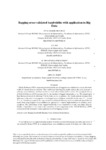Mostrar o rexistro simple do ítem
Bagging cross-validated bandwidths with application to big data
| dc.contributor.author | Barreiro-Ures, Daniel | |
| dc.contributor.author | Cao, Ricardo | |
| dc.contributor.author | Francisco-Fernández, Mario | |
| dc.contributor.author | Hart, Jeffrey D. | |
| dc.date.accessioned | 2023-11-24T18:50:54Z | |
| dc.date.available | 2023-11-24T18:50:54Z | |
| dc.date.issued | 2021 | |
| dc.identifier.citation | D Barreiro-Ures, R Cao, M Francisco-Fernández, J D Hart, Bagging cross-validated bandwidths with application to big data, Biometrika, Volume 108, Issue 4, December 2021, Pages 981–988, https://doi.org/10.1093/biomet/asaa092 | es_ES |
| dc.identifier.uri | http://hdl.handle.net/2183/34333 | |
| dc.description | Versión final aceptada de: https://doi.org/10.1093/biomet/asaa092 | es_ES |
| dc.description | This is a pre-copyedited, author-produced version of an article accepted for publication in [insert journal title] following peer review. The version of record of: D Barreiro-Ures, R Cao, M Francisco-Fernández, J D Hart, Bagging cross-validated bandwidths with application to big data, Biometrika, Volume 108, Issue 4, December 2021, Pages 981– 988, https://doi.org/10.1093/biomet/asaa092, published by Oxford University Press, is available online at: https:// doi.org/10.1093/biomet/asaa092. | es_ES |
| dc.description.abstract | Hall & Robinson (2009) proposed and analysed the use of bagged cross-validation to choose the band-width of a kernel density estimator. They established that bagging greatly reduces the noise inherent in ordinary cross-validation, and hence leads to a more efficient bandwidth selector. The asymptotic theory of Hall & Robinson (2009) assumes that N , the number of bagged subsamples, is ∞. We expand upon their theoretical results by allowing N to be finite, as it is in practice. Our results indicate an important difference in the rate of convergence of the bagged cross-validation bandwidth for the cases N = ∞ and N < ∞. Simulations quantify the improvement in statistical efficiency and computational speed that can result from using bagged cross-validation as opposed to a binned implementation of ordinary cross-validation. The performance of the bagged bandwidth is also illustrated on a real, very large, dataset. Finally, a byproduct of our study is the correction of errors appearing in the Hall & Robinson (2009) expression for the asymptotic mean squared error of the bagging selector | es_ES |
| dc.description.sponsorship | The authors thank Andrew Robinson, a referee, the editor and an associate editor for numerous useful comments that significantly improved this article. The authors are also grateful for the insight of Professor Anirban Bhattacharya. The first. three authors were supported by the Spanish Ministry of Economy and Competitiveness (MTM2017-82724-R) and by the Xunta de Galicia (ED431C-2016-015, ED431C-2020-14 and ED431G 2019/01). The work of Barreiro-Ures was carried out during a visit to Texas A&M University, College Station, financed by Inditex. | es_ES |
| dc.description.sponsorship | Xunta de Galicia; ED431C-2016-015 | es_ES |
| dc.description.sponsorship | Xunta de Galicia; ED431C-2020-14 | es_ES |
| dc.description.sponsorship | Xunta de Galicia; ED431G 2019/01 | es_ES |
| dc.language.iso | eng | es_ES |
| dc.relation | info:eu-repo/grantAgreement/AEI/Plan Estatal de Investigación Científica y Técnica y de Innovación 2017-2020/MTM2017-82724-R/ES/INFERENCIA ESTADISTICA FLEXIBLE PARA DATOS COMPLEJOS DE GRAN VOLUMEN Y DE ALTA DIMENSION | es_ES |
| dc.relation.isversionof | https://doi.org/10.1093/biomet/asaa092 | |
| dc.relation.uri | https://doi.org/10.1093/biomet/asaa092 | es_ES |
| dc.rights | Todos os dereitos reservados. All rights reserved. | es_ES |
| dc.subject | Bagging | es_ES |
| dc.subject | Bandwidth | es_ES |
| dc.subject | Big data | es_ES |
| dc.subject | Cross-validation | es_ES |
| dc.subject | Kernel density | es_ES |
| dc.title | Bagging cross-validated bandwidths with application to big data | es_ES |
| dc.type | info:eu-repo/semantics/article | es_ES |
| dc.rights.access | info:eu-repo/semantics/openAccess | es_ES |
| dc.identifier.doi | 10.1093/biomet/asaa092 |
Ficheiros no ítem
Este ítem aparece na(s) seguinte(s) colección(s)
-
GI-MODES - Artigos [137]






